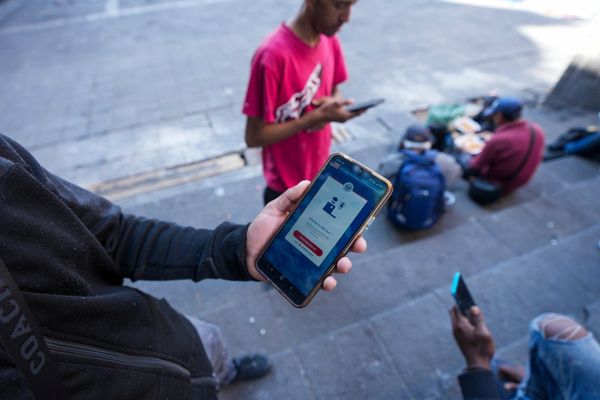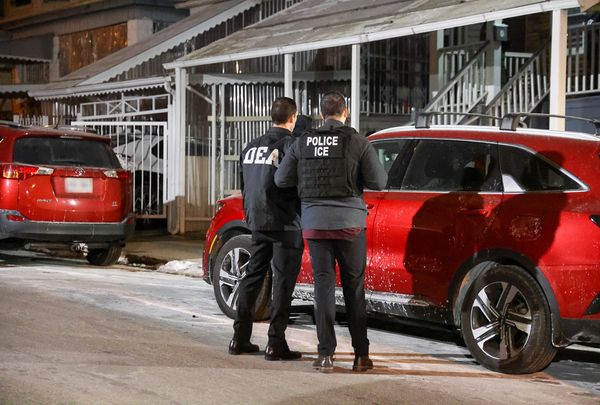It was school pick-up time and Sarah Haar was driving a route she'd taken countless times before.
She realised she was low on fuel, so she changed lanes as she took an exit from the Citylink freeway to a road in Melbourne's inner north.
She said there was one car in the next lane, with a safe distance between them. But she said the driver accelerated so she couldn't get into the lane, then started "honking aggressively".
He then started following her as she drove away.
She said she didn't want to get out of the car to fill up, or lead the man to where her young child had just started attending school.
"I just did every manoeuvre I could think of to get away, tried to change lanes, he changed lanes behind me, turned on to the side streets, he followed me," she said.
She said although she was trying to appear calm and not engage the other driver, she was getting increasingly worried about what she could see in her mirrors.
"He started pointing towards my car, picked up these two white latex gloves," she said.
She said after he "slowly and theatrically put those on his hands", he started making gestures that she interpreted as choking motions.
It brought what she called a "primal fear" as a woman alone in her car.
About 10 minutes into the incident, and in "panic mode", she called triple-0.
"I think he could see my dash unit, it's pretty big … and at around that point is where I lost him," she said.
After picking up her son, she went to the Brunswick Police Station, where she was told there did not appear to be any grounds to file a police report.
She then asked for an incident report number so she could explain to her work why she had been away for longer than anticipated, which the officer said would not be possible either.
Ms Haar said in her discussions with the officer at the station, she did not feel confident the incident was being taken seriously.
A Victoria Police spokesperson confirmed an alleged road rage incident was reported to police on February 2.
"Investigators were told there was an incident on Citylink near Moreland Road about 3pm which resulted in a male driver gesticulating at a female driver," the spokesperson said.
"At this stage no offences were identified but the matter is still active if further evidence comes to hand."
'Road rage' not a crime, but other offences can occur during road rage incidents
There is no set definition for what constitutes road rage. A 2005 Victorian parliamentary inquiry, for instance, made the distinction between road violence, road hostility and selfish driving.
They defined road violence as "spontaneous, driving related acts of violence that are specifically targeted at strangers, or where strangers reasonably feel they are being targeted".
Road hostility, according to the inquiry, is "spontaneous, driving related non-violent but hostile acts that are specifically targeted at strangers, or where strangers reasonably feel they are being targeted".
In Victoria, a range of actions which occur during a road rage incident can be considered crimes, including assault, dangerous driving, tailgating and property damage.
But "road rage" is not an offence under the law.
"When it comes from a stranger, it's really threatening. And it's designed to make you uncomfortable and fearful on the road," Ms Haar said.
Ms Haar said she understood why police could not investigate all reported road rage incidents, but she felt there was a gap in the system.
"The EPA is a really good example. So the Act allows public citizens to file a report for littering, or for smoky cars for cigarette butts flicked out of a car," she said.
"I think something like that, that could be used to report, road rage, or aggressive behaviour on the road would be really, really useful for police to be able to then follow up.
"But at the moment, what we have is a system that doesn't really address this at all."
Her suggestion is not new — the 2005 parliamentary inquiry recommended that the Department of Justice establish a road violence hotline.
It made four other recommendations relating to the establishment of a hotline, including that complaints be made in writing and "that the data contained in the complaint forms should be used by Victoria Police for intelligence and prevention purposes".
Also among the 69 recommendations from the inquiry were changes to licence tests, a community information campaign and protocols for journalists about reporting on road violence.
Victoria's Crime Stoppers does have a Hoon Hotline, where residents can report hoon driving, but no dedicated service to report road rage.
Victoria Police records some road-related offences under the name of 'road user violence/ confrontation'.
Offences recorded under the subdivision of 'assault and related offences' are the most common, data from the Crime Statistics Agency shows.
The year with the highest number of incidents in that category was between October 2015 and September 2016, with 432 offences officially reported on the police LEAP database.
Other offences which have been recorded under the 'road user violence/ confrontation' modus operandi code include property and deception offences such as property damage. Drug offences, public order and security offences and justice procedures offences are also recorded under the same code in much smaller numbers.
When providing the data to the ABC, the agency noted that the information was not a mandatory field and was subject to police recording practices, so may not be reflective of all incidents.
The ABC asked the state government whether there were any plans to create a road rage hotline or any other moves to respond to the issue.
"Road safety is everyone's responsibility and it is critical that motorists treat each other with respect on our roads — dangerous driving, including instances of road rage are unacceptable," a government spokesperson said in a statement response.
"If someone witnesses another person being dangerous, threatening or irresponsible on the road then they should report it to Police if safe to do so."
Driving environment 'seen as becoming more aggressive'
With "road rage" being a hard-to-define term and data collection patchy, much of the best research uses self-reporting to study the phenomenon.
A paper by the Monash University Accident Research Centre last year found "the driving environment is seen as becoming more aggressive, both gradually and as a direct result of COVID-19 lockdowns".
"The data indicate that this perceived increase in aggression is likely to provoke higher levels of aggression in some drivers," the authors found.
"Campaigns to reduce aggression on the roads need to focus on changing road culture and improving interactions, or perceived interactions, among road users."
Other research suggests road violence is carried out by people who are likely to display similar behaviour elsewhere in their lives.
A paper written by Melbourne researchers for the national Criminology Research Council in 2011 backed up earlier studies showing there was "no major difference between the general characteristics of 'road violence' offenders compared to violent offenders in general".
"Thus, when the most serious end of the spectrum of 'road rage' … is considered, road rage offenders resemble other perpetrators of violence against strangers," the authors wrote.
The head of policy for the RACV, James Williams, said it the organisation was "concerned about unsafe road user behaviour, including road rage, hoon driving and speeding, which puts road users at risk".
"RACV continues to engage with the Victorian government to highlight the importance of safety and the need to better protect all road users," he said in a statement.
He said drivers caught up in road rage situations should get out of the way of the offending vehicle, not make eye contact, contact authorities providing any identifying information, drive to a busy public site with witnesses or a police station and keep the windows up and the car doors locked.
"It is most important to continue to drive safely and not to engage with the offending driver," he said.
"Road rage can be related to underlying emotional issues, so try not to escalate the situation."
After visiting the police station, Ms Haar emailed the officer to express her disappointment that it did not generate an incident report. She did not receive a response.
"I think that there's so many people that have experienced this type of behaviour on the road and are quite fearful when they drive around," Ms Haar sad.
"And I think that we've left this part of road safety grey for a really long time. And now's the time to really fix it."







